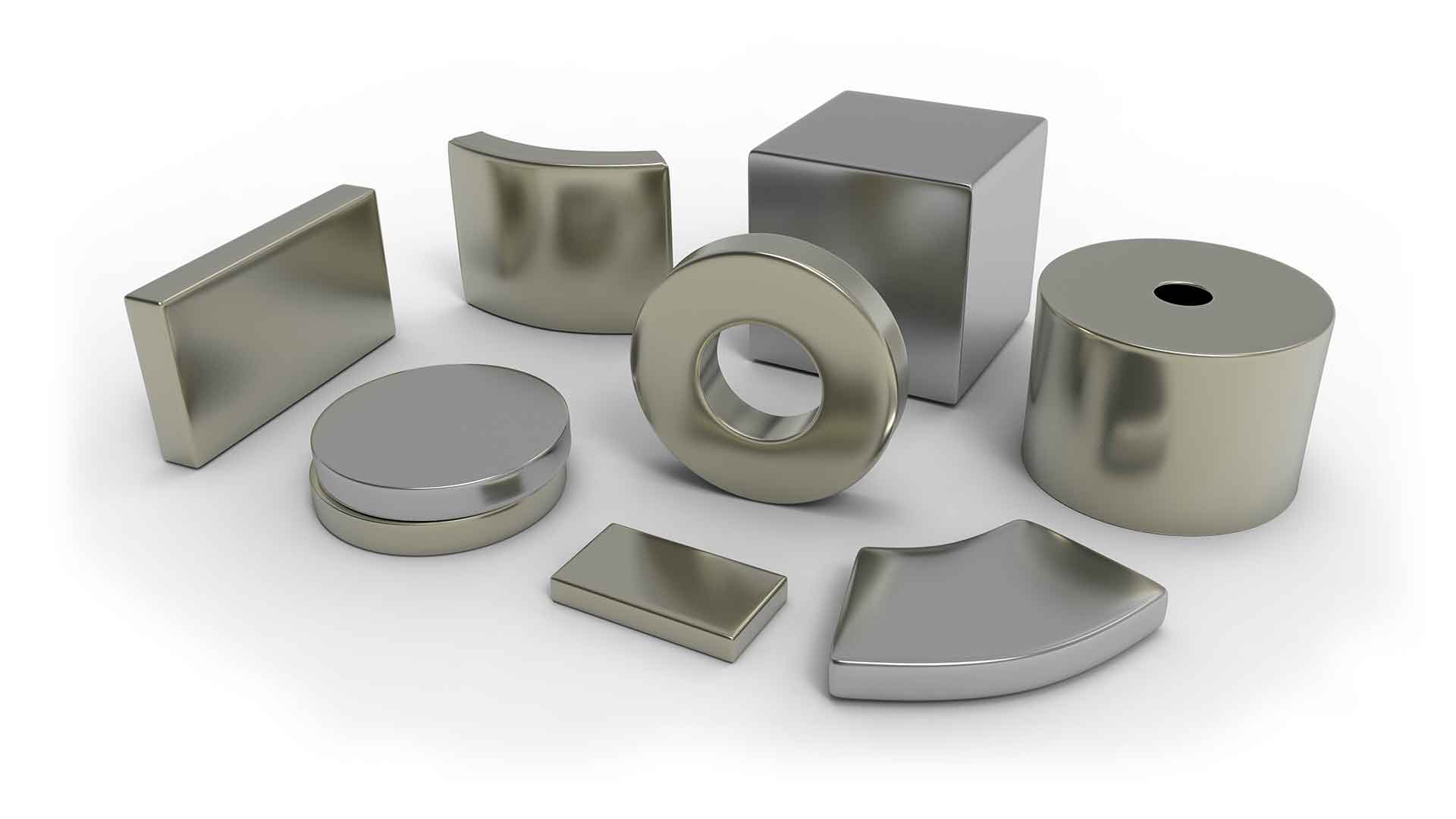Boron Neodymium Magnets
Boron Neodymium Magnets are “Super Magnets”. Neodymium (Nd-Fe-B) magnets are rare earth magnets composed of neodymium, iron, boron, and several transition metals. The elements of neodymium are classified as “rare earth” magnets because they lie in the lanthanides section on the Periodic Table.

Boron in Neodymium Magnets
A Neodymium magnet is a type of permanent magnet that uses the power of neodymium (NdFeB), one of the strongest substances known. It exhibits superior resistance to heat and corrosion, as well as elevated tolerance for ferromagnetic materials in close contact with it. These ‘strong for their size’ magnets provide the vital components needed in many modern-day devices that we use daily.
It is thought that neodymium magnets are the most powerful permanent magnet. This may be because they’re one of the smallest types of rare earth magnetic materials, and thus have a higher density per volume than other more common metals such as iron or copper.
Neodymium magnets are the ‘go’-to’ magnet in industries requiring low heat, high power sources in confined spaces. Without them, we would not have been able to make advances over the last 30 years in areas such as medicine and renewable energy production since these sectors rely on super-strength neodymium magnets to produce a powerful magnetic field for motors they use.
Boron neodymium magnets also help hobby enthusiasts in crafts or modelling because of their strong force. You can more easily connect two pieces without any welding necessary. Because they are super-strong and resistant to magnetic demagnetization, these magnets can be made in many shapes and sizes. They can hold up heavy objects from one place- even when you change their shape, making them an amazing tool!
Let’s look at applications of neodymium magnets. First, the hard disk. A hard disk drive records data by magnetizing and demagnetizing a thin film of ferromagnetic material on a disk. Each track has many tiny individual magnetic cells which are magnetized by the read/write head when data is written to the drive. Hard drives use heads crafted from ferrite wrapped in exceptional cord coil that, whilst energized through an electromagnetic field (EMF), forms strong magnets for recording adjacent surfaces where they write crucial information about your business or application’s process flow as it moves down through each level of the hierarchy until reaching its destination at an end-user station.
The use of audio equipment such as microphones, acoustic pick-ups, headphones, and loudspeakers for making sound is a further application. They can be traced back to the permanent magnets in speakers like those found alongside a current-carrying coil that converts electricity into mechanical energy, which moves the speaker cone.
The movement causes pressure changes around it, resulting in sounds produced by airwaves vibrating through its surroundings. In reverse, this process is also used with microphones where diaphragms are attached to coils situated within magnetic fields created by permanent magnets creating electrical signals when subjected to sound vibrations from various sources including human speech or musical instruments.
For magnetically coupled pumps, neodymium magnets have two main advantages over non-magnetic ones. The first is that if the impeller becomes obstructed, it can continue to turn without damaging the motor because they are magnetically connected and separated only by a thin layer of air. Secondly, in applications where liquid could potentially seep into the unit (for example, pond motors), it is possible to separate any corrosion damage from occurring since there’s no metal within reach for rust or other decay mechanisms.
Magnetic door catches for use in public, commercial and residential buildings use neodymium magnets to create magnetic door catches. Countersunk or pot magnets recessed into the surface of a door are used to attract another wall-mounted magnet or steel disk. Strong neodymium magnets will easily hold the weight of heavy doors that can be opened by hand which means they don’t need any screws or bolts for installation.
Neodymium magnets in jewellery are small and have a counter-bored neodymium magnet. These magnets provide the strongest magnetic hold of any material, making them useful on 5mm diameter pieces for clasps that secure jewellery together without worry about it coming undone due to weight loss or other issues with clasp closure.
An MRI scanner does not just help doctors see what is going on inside our bodies but also helps save lives. The device uses a large magnetic field to align the protons in your body and then passes radio frequency waves at you which produce detailed images of anything that could be wrong with your internal organs or tissues. Open-MRI machines used by hospitals typically use neodymium magnets for this purpose because they are stronger than other types of magnets.
The process of eliminating contaminants is a vital step in production and processing. This can be done using either physical or magnetic separation methods, though the latter is more common due to their versatility. Strong filter rod magnets usually do the work by attracting ferrous items like metal while repelling paramagnetic ones such as plastic bags which may have been accidentally introduced into an assembly line at some point during manufacturing.
A reed switch is a magnetic-powered switch that detects the opening and closing of doors in burglary alarm systems. They consist of two ferrous (iron-containing) contacts encased in a sealed glass tube, which can be made to open or close by default depending on how they are designed when inactive. Bringing a magnet near it will power the device from inside its case with an electromagnetic field; this activates them as well as opens up their hinge at one end so that pressure may then push them either closed again if needed for safety purposes or shut permanently where applicable per your preference.
Powerful Neodymium magnets are popular among craft enthusiasts and model-makers. They generate enough magnetic pull to be effective even with a tiny magnet, which makes them the perfect choice for miniature wargaming enthusiasts who need powerful neodymium magnets to configure models used in games such as Warhammer or people who make handmade stationery and cards.
Small neodymium magnets are widely used in the print finishing industry as a thin magnet will be powerful enough to attract another magnet even if both are secreted beneath a layer of card, paper, or plastic. We have many customers that use our magnets as hidden closures for brochures, binders, boxes, and high-end packaging which usually consists of pairs but can also be achieved by one large steel disc with its magnetic power.
If you are looking for a cost-effective way to find and retrieve heavy ferrous items, large neodymium magnets may be just the ticket. Neodymium is an incredibly strong magnet that can lift objects weighing hundreds of pounds with ease, making it perfect for recovering these kinds of metals from places as deep water or mud where other methods might not work well.
There are some hazards related to neodymium magnets, which are worth calling out here.
Neodymium magnets are the strongest permanent magnet in production. They can be dangerous if handled carelessly, so it is important to take precautions when handling them. Fingers may get pinched between two attracting neodymium magnets and chips will form on their surfaces by jumping at an attractive object such as a metal surface or another ferrous material that contains iron.
These powerful rare earth magnetic spheres should never come into contact with children because their strength means even one small sphere could cause harm to a child’s finger. It is better for people who intend to construct these devices from scratch to find ways not just to keep them separate but also avoid any injury caused by mishandling during construction.
Due to its susceptibility, Neodymium no longer lend itself to traditional machining processes. The only way that it can be processed with such methods is if liberal amounts of coolant are used before and during the process which helps reduce heat fracturing risks as well as those from oxidized grinding dust.
And that’s all for this podcast. For more information on topics related to boron neodymium magnets, please refer to our website Borates Today. Thanks for listening.





